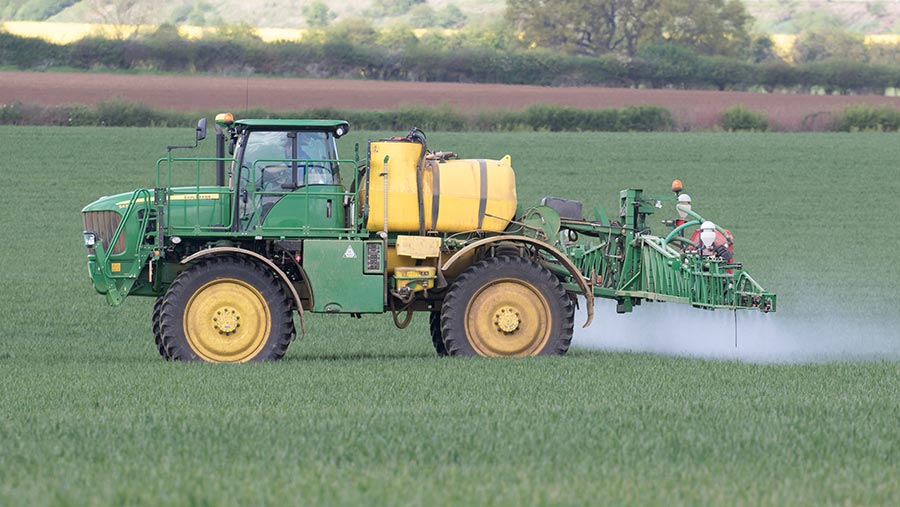How plant sap analysis helps a grower cut disease control costs
 © Tim Scrivener
© Tim Scrivener A Shropshire farmer is among the first to be using plant sap analysis in the UK to improve crop plant health, with reducing fungicide inputs among the benefits.
It is a continuation of Harry Heath’s transition towards a regenerative farming model on 300ha of arable.
“It was four or five years ago, we recognised that soil health was in decline on our farm.
“It’s the medium we grow our crops in, so it is important we look after it, not just for the short-term for our own productivity and profitability, but also to hand it onto the next generation.”
See also: Why questions remain over new fungicide performance in 2021
That has led to a gradual move away from intensive cultivations to direct-drilling, grazing cover crops in the rotation, and employing a flexible approach to cropping.
Rotation changes
Potatoes have been dropped because he felt they would undo some or all of what he is achieving in building soil health in the rest of the rotation.
Barley is also no longer grown because of resistant ryegrass populations, whereas crops such as hybrid rye and sunflowers have been introduced to sit alongside winter wheat, oilseed rape and winter beans.
“It’s a slow job – it takes time to make changes and see them come to fruition,” he notes.
“But we’re well on the way now. With more extreme weather, you have to work with nature rather than against it.”
There is also a focus on avoiding detrimental soil impacts with inputs as much as possible.
Seed dressings have been dropped completely, with a move to home-saved seed contributing to greater flexibility in drilling date and crop choice.
“We need to move away, where we can, from our reliance on chemical control.
“But we’re not quite at the stage where we can pull back on all inputs significantly, as it takes a long time to get the soil biology and nutrient cycling working correctly on your farm.”
Four-way blends of winter wheat varieties Crusoe, Extase, Costello and Gleam have been introduced as part of the tactics to ultimately reduce fungicide inputs.
In a trial last season, the blend yielded 9.5t/ha compared with 9.25t/ha average for the rest of the winter wheat, with Mr Heath observing less disease in the blend.
That success means the blend has been rolled out across a wider area this season. “We keep making small changes that we think will help us significantly impact our fungicide spend.”
Sap analysis is part of that change. Leaves are sampled three times during the spring, and the sap analysed for all macro- and micronutrients critical for growth.

Harry Heath © Hutchinsons
“Crop nutrition is important to get right, and sap analysis is allowing us to manage it proactively rather than following a pre-season plan, which the weather invariably changes,” Mr Heath says.
“I’ve been amazed at how useful it has been in identifying a broad spectrum of nutrient requirements and allowing us to actively manage any crop deficiencies through the growing stages of the crop.
“If you can reduce that stress on the plant, long before you see anything by eye, you stand every chance of maximising productivity.
“It helps us to understand the crop on a higher level than we can see walking through it.”
Why sap analysis?
The philosophy behind sap analysis is by growing a healthy plant in a healthy soil, it should be possible to reduce fungicide inputs, says his agronomist Ed Brown of agronomy group Hutchinsons.
“That will help cut costs, which is an area I’m often asked about by growers.”
“But first, you must have a healthy soil. Once you’re getting your soil nutrition bit right, the sap analysis will help you fine-tune in season.”
He uses Dutch laboratory NovaCropControl for the analysis, which he believes is unique in testing sap separately from old and new leaves.
Analysing both means nutrient mobility in the plant can be assessed and help predict deficiencies, as well as identifying whether there is already one, he explains.
“If sap analysis tells me the old leaves are running short of potassium, while the new leaves seem OK, it means the plant is sending its potash reserves to new growth as it is not getting it from the soil and it’s going to run out.
“I can do something about that before it is showing a deficiency and impacts yield.
“Conversely, calcium and boron, which we know are immobile in the plant – if we have enough in old leaves, but not in new growth, I know it can’t pull from the old leaves, so I know I need to feed that.”
There are also three measures of nitrogen – ammonium, nitrate and total nitrogen. “You’re looking for target nitrogen, but preferably not too much ammonium or nitrate in the leaf, as we know nitrate attracts pest and diseases.”
In addition to about 16 nutrients, the sap is also analysed for EC (a measure of salts) and total sugars, as well as pH.
“They’re all good general measures of plant health, especially sugars. If they’re too low, the plant isn’t functioning as it should – usually because it isn’t photosynthesising enough.
“If they are too high, it’s taking up lots of nutrition, but for some reason can’t convert it into more complex carbohydrates and proteins.”
Timing
On Mr Heath’s farm last season, samples were taken pre-stem extension, around stem extension (GS32) and at flag leaf fully emerged (GS39) from a couple of representative fields of wheat, Mr Brown says.
The results led to nutritional inputs of Bittersaltz, manganese and boron at both GS30 and GS32.
Molasses and a seaweed extract were also applied at the first of those timings, while fulvic acid, which helps gets the nutrition into the leaf, was applied at the second. Bittersaltz and copper were added to the flag leaf spray.
“The good thing was as we applied nutrients the sap analysis was telling us we were short of, we saw a response in the crop at the following analysis.”
Only two fungicides were used – Firefly (prothioconazole + fluoxastrobin) at T1 and Revystar (mefentrifluconazole + fluxapyroxad) at T2 – a much lower input programme than the four-spray approach that had been used on the farm.
“Our programme with the nutrition costs about £85-£90/ha compared with £105-£120/ha for a four-spray approach with a manganese and Bittersaltz added,” he estimates.
While there were no split field trials last season – something which is going to happen this season – Mr Brown says he felt they were managing healthy crops.
“We were certainly never at a point where the disease got ahead of us. Other growers locally were struggling with septoria towards the end of the season, but we weren’t.
“What we hope to see as the regenerative system gets established with the diverse rotation in place and with healthier soils, is that we can continue to reduce fungicides, supported by growing blends and using sap analysis to get our nutrition right, while the applied nutrition shouldn’t get any higher,” Mr Brown concludes.
Harry Heath disease control and nutrition programme informed by sap analysis |
||
|
Timing |
Fungicide |
Nutrition |
|
GS30 (T0) |
nil |
Mg, Mn, B, molasses and seaweed |
|
GS32 (T1) |
Firefly (1.0 litre/ha) |
Mg, Mn, B and fulvic acid |
|
GS39 (T2) |
Revystar (1.0 litre/ha) |
Mg and Cu |
|
GS65 (T3) |
nil |
nil |

